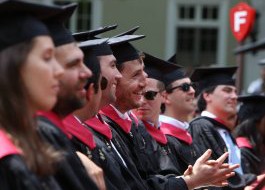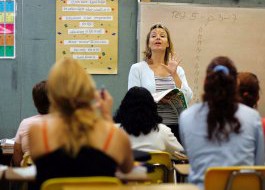
TAESUNG FREEDOM VILLAGE, South Korea (Reuters) - For South Korean schoolgirl Lee Su-jin, the daily commute into one of the world's most heavily armed zones, trundling past barbed-wire fences, military checkpoints and anti-tank barricades, has become routine.
The 11-year-old's school sits in the Korean peninsula’s Demilitarized Zone (DMZ), a 4-km (2.5-mile) wide buffer between North and South Korea that former U.S. President Bill Clinton once called "the scariest place on Earth".
Lee is one of 25 children who ride the bus from nearby towns to the Daesungdong Elementary School, located in Taesung Freedom Village, a settlement on the southern side of the DMZ.
"People are worried about us, but soldiers are with us, and we do evacuation drills. So I don't think there is anything to be scared or worried about," the fourth grader told Reuters.
Places at her school, just a few steps from North Korea, are coveted by South Koreans living near the border, as it offers their children a rare opportunity to learn English from American soldiers and United Nations officials overseeing a fragile truce that followed the 1950-53 Korean War.
The school has 29 pupils this year, against a quota of 30 agreed with United Nations officials. With just four children from the village itself, authorities allot places by lottery for those who live elsewhere.
Students pay no fees for classes or meals.
Parents consider the extracurricular lessons in English, a key subject in school and college entrance exams, give children an advantage over private, and often expensive, alternatives available elsewhere in the South.
"My mom recommended this school," Lee said.
The school opened initially for children of farmers allowed to stay in the DMZ after the war. Isolated North Korea and the wealthy, democratic South are still technically at war after the conflict ended in an armistice, not a peace treaty.

In 2008, facing extinction as the surrounding population dwindled, the school opened its doors to South Korean children living outside the DMZ.
At the same time, the U.S.-led United Nations command headquarters began sending soldiers there to teach English twice a week.
"Our students' parents are very interested in their children learning English, and ask a lot about their English ability," said Lee Hyun-sun, the school's vice principal.
Bryan Waite, a 22-year-old American sailor and volunteer teacher, said the school allowed students to practice English speaking skills and learn about the history of the area.
"It's a unique experience and it's very important that the children, from a young age, are exposed to English and to knowing what the DMZ is, and how it comes into play in their lives and the history behind it," Waite said.
In contrast to the upbeat mood in the classroom, an uneasy tension hangs over the village. The steady drone of North Korean music comes over the border, where farmers work under military supervision.
Unless they have a military escort, students are forbidden to venture outside the school, which faces north, and has a frontage packed with bricks to protect against stray bullets.
Teachers and children must leave the school every day ahead of a curfew that runs from midnight to 5 a.m.
Despite the risks, there is a certain peace in the desolate zone, said vice principal Lee.
"When I cross into the southern boundary, my mind is really peaceful," he said. "I've never felt anything dangerous."
(Additional reporting by Nataly Pak; Editing by Jack Kim, Darren Schuettler and Clarence Fernandez)
Read the original article on Reuters. Copyright 2016. Follow Reuters on Twitter.




